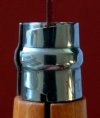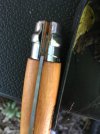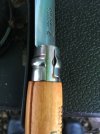I wonder how many "non-knife folk" would buy an Opinel.
Might be better divided into those who want to tinker with it and those who don't. I'd be willing to bet there are a fair amount of tinkerers, especially with people who own a few.
Dave, I can answer that question.
Some years ago my better half and I knew a young lady that was the manager of a Chesapeake Knife And Tool store in a mall. Joanne, Jo for short. One evening over a few cocktails we were talking about that subject and her customer categories. The had many brands of knives in the stores to include Spyderco, Benchmade, Camillus, Schrade, (still in business in the U.S. at that time, Buck, Victorinox, Opinel, Al Mar, Ontario, Matini, Helle, Gerber, Case, and others.
Jo said after a while she got so that she could classify the customers right off in 30 seconds. The young guys that were knife nuts went right to the case with the one handers in it like the Spydercos and Benchmades. The old guys went to the Buck and Case displays. The people who didn't know much if anything about knives, just browsed until they saw the display with the red handles and silver crosses and exclaimed "Oh look, Swiss Army knives!" and usually bought something from that display. Or someone would walk in and browse, and when asked if they cold be helped they'd reply they were looking for something small to keep in a pocket. After being shown small Al Mar's, little Spydero models, they'd see the SAK stand and buy a small SAK, again with that comment "Oh, Swiss Army knives." Jo even played with the stand up rotating SAK display by moving it all the way to the farthest counter from the door, but the non knife nuts would just kind of browse aimlessly until they saw the Victorinox display. It was like they didn't really know what they were looking for, but when they saw the SAK display something clicked in their head. She said for every Spyderco or other higher end production knife out the door, at least three to four SAK's went out the door. They moved more SAK's than any other three brands of knife.
By comparison the Opinel's were a low volume sales item. I was one of her biggest repeat sales. I'd buy one and sand and stain and modify to gift it off to a non knife person. Then I'd start over with another new Opinel. That and SAK classics. Now I gift off Victorinox recruits or classic's depending on the person.
This all from a manager of a knife shop.
Last edited:



